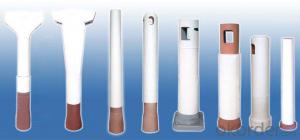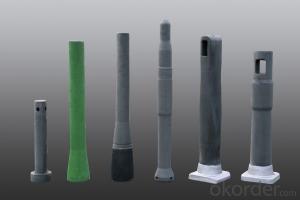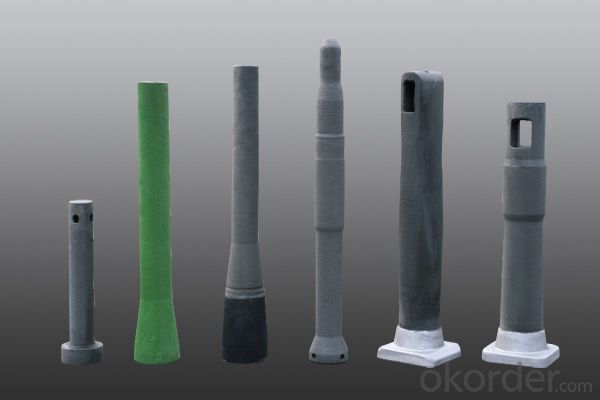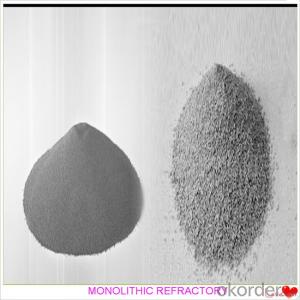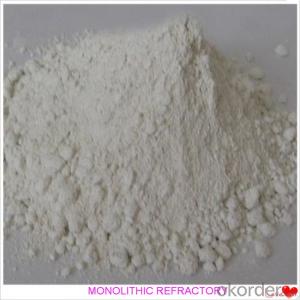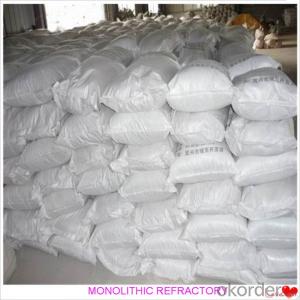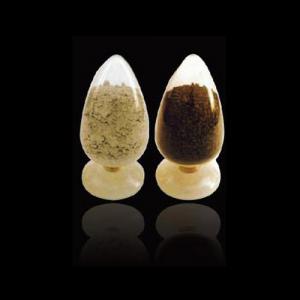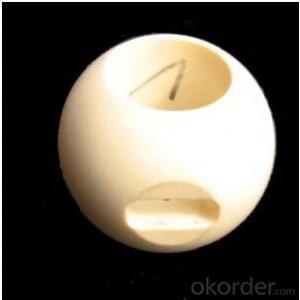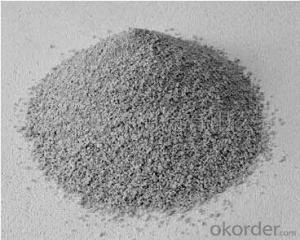Sen Monolithic Refractories for Iron and Steel Industry Melting Furnace Refractory Material
- Loading Port:
- Shanghai
- Payment Terms:
- TT OR LC
- Min Order Qty:
- 10 set
- Supply Capability:
- 50000 set/month
OKorder Service Pledge
OKorder Financial Service
You Might Also Like
Specifications
sen
Long life
Reliable
ISO9001
High thermal shock resistance.
1.New type Composite subemeged nozzle
Advantage
long life,10hours
high thermal shock resistance
and reliable flow control.
Applicable to the C.C. of the billet, slab, round and bloom for the converter, and EAF,
pouring for more than 400 min .
Application
Applicable to the C.C. of the billet, slab, round and bloom for the converter, and EAF, pouring for more than 400 min,and compositions and specifications can be adjusted according to the specific requirement of the customer.
Specifications
No. | SK6-7 | SK6-8 | SK6-9 | SK6-10 | SK6-11 | SK6-12 |
Name | Submerge entry nozzle(SEN) | |||||
Body | Slag-band | Body | Slag-band | Body | Slag-band | |
Al2O3 % | ≥45 | ≥45 | ≥50 | |||
C+SiC % | ≥30 | ≥13 | ≥30 | ≥13 | C≥26 | ≥13 |
ZrO2 % | ≥4 | ≥75 | ≥4 | ≥75 | ≥3 | ≥75 |
B.D.g/cm3 | ≥2.3 | ≥3.5 | ≥2.3 | ≥3.5 | ≥2.25 | ≥3.5 |
A.P. % | ≤19 | ≤19 | ≤19 | ≤19 | ≤18 | ≤19 |
CCS MPa | ≥20 | ≥20 | ≥20 | ≥20 | ≥20 | ≥20 |
H.M.O.R MPa |
≥6 |
≥6 |
≥6 |
≥6 |
≥6 |
≥6 |
Thermal shock resistance times |
≥5 |
≥5 |
≥5 |
≥5 |
≥5 |
≥5 |
Details of Al2O3-ZrO2-C Al2O3 anti-clogging SEN |
Series of Al2O3-ZrO2-C material in the body can be applied to different steel grades. The latest new type of low silica material has more higher thermal stability, erosion resistance compared with traditional materials.
Series of compound materials for slag line. |
- Q: What are the common failure modes of monolithic refractories in iron and steel applications?
- The common failure modes of monolithic refractories in iron and steel applications include thermal spalling, erosion, chemical attack, and mechanical damage. Thermal spalling occurs when the refractories cannot withstand the extreme temperature changes, leading to cracking and flaking. Erosion occurs due to the abrasive nature of molten metal or slag, causing the refractory material to wear away. Chemical attack happens when the refractory reacts with the corrosive components of the molten metal or slag, leading to degradation. Mechanical damage can occur from mechanical stress, such as thermal expansion or contraction, causing cracks or fractures in the refractory material.
- Q: How do monolithic refractories help in reducing energy consumption in iron and steel production?
- Monolithic refractories play a vital role in the reduction of energy consumption in iron and steel production. These refractories are heat-resistant materials utilized to line the walls and floors of furnaces and other high-temperature equipment. One of the main ways monolithic refractories aid in energy reduction is through their exceptional thermal insulation properties. These materials possess low thermal conductivity, which effectively minimizes heat loss from the furnace or equipment. By keeping heat loss to a minimum, monolithic refractories help maintain a consistent and high temperature inside the furnace, resulting in enhanced energy efficiency. This allows for better utilization of generated heat, reducing the need for additional energy input and ultimately leading to energy savings. Additionally, monolithic refractories exhibit high thermal stability and resistance to thermal shock. This enables them to withstand the extreme temperatures and rapid temperature changes frequently encountered in iron and steel production processes. By having a robust and dependable lining, these refractories prevent heat leakage and ensure efficient heat transfer to desired areas, reducing energy wastage. Furthermore, monolithic refractories contribute to energy reduction by resisting chemical attack and erosion. In iron and steel production, furnaces and equipment linings are exposed to aggressive substances like molten metal, slag, and gases. Monolithic refractories exhibit excellent resistance to these corrosive elements, prolonging their lifespan and reducing the need for frequent repairs or replacements. This not only saves energy required for maintenance but also avoids production interruptions and associated energy losses. In conclusion, monolithic refractories aid in the reduction of energy consumption in iron and steel production by providing effective thermal insulation, withstanding extreme temperatures, and resisting chemical attack. By optimizing heat management and extending equipment durability, these refractories significantly contribute to energy efficiency and cost savings in the industry.
- Q: What are the key differences between acidic and basic monolithic refractories?
- The key differences between acidic and basic monolithic refractories lie in their chemical composition and the type of environments they can withstand. Acidic refractories are made of silica or alumina and can withstand acidic environments, such as those containing sulfur or phosphorus. On the other hand, basic refractories are made of magnesia or dolomite and are resistant to basic environments, such as those containing calcium oxide or alkalis. Additionally, acidic refractories have higher thermal shock resistance, while basic refractories have higher resistance to chemical attack.
- Q: How do monolithic refractories perform in reheating furnace applications?
- Monolithic refractories are highly effective in reheating furnace applications due to their exceptional thermal stability, strength, and resistance to thermal shock. These refractories are designed to withstand high temperatures, rapid temperature changes, and harsh operating conditions commonly found in reheating furnaces. One of the key advantages of monolithic refractories in reheating furnace applications is their ability to provide a seamless lining. Unlike traditional brick refractories, which require extensive installation and joints, monolithic refractories can be easily applied as a single, homogeneous layer. This eliminates the risk of thermal stress and cracking at joints, ensuring a more reliable and durable lining. Additionally, monolithic refractories offer excellent thermal insulation properties, which help to conserve energy and reduce heat loss in the reheating furnace. This not only improves the overall efficiency of the furnace but also reduces operational costs. Moreover, monolithic refractories exhibit high mechanical strength, allowing them to withstand the mechanical stress and abrasion caused by the movement of the furnace charge. They also have good resistance to chemical attack from gases, slags, and molten metals commonly encountered in reheating furnace operations. Furthermore, monolithic refractories can be easily repaired or patched, minimizing downtime and ensuring continuous furnace operation. Their ability to be easily shaped and molded to fit various furnace geometries also makes them highly versatile and adaptable to different reheating furnace designs. Overall, monolithic refractories offer exceptional performance in reheating furnace applications by providing superior thermal stability, strength, and resistance to thermal shock. Their seamless lining, thermal insulation properties, and resistance to mechanical and chemical stress make them an ideal choice for ensuring reliable and efficient furnace operation.
- Q: How long is the lifespan of monolithic refractories in iron and steel applications?
- The lifespan of monolithic refractories in iron and steel applications can vary depending on several factors such as the specific type of refractory material used, the operating conditions, and the maintenance practices. However, on average, monolithic refractories in iron and steel applications can last anywhere from a few months to several years.
- Q: How do monolithic refractories withstand the mechanical impacts in ladle lip applications?
- Monolithic refractories are able to withstand the mechanical impacts in ladle lip applications due to their unique properties and composition. Firstly, monolithic refractories are made from a single, homogenous material, which provides them with a high level of structural integrity. This means that they are less vulnerable to cracking or breaking when subjected to mechanical impacts. Additionally, monolithic refractories often contain additives such as fibers or aggregates, which further enhance their resistance to mechanical stresses. These additives help to distribute the forces applied to the refractory material, reducing the concentration of stress points and increasing its overall durability. Furthermore, the application process of monolithic refractories allows for a seamless and continuous lining, eliminating the presence of joints or weak points that are susceptible to mechanical damage. This ensures a more uniform distribution of the impacts and enhances the material's ability to withstand them. Moreover, monolithic refractories can be designed with specific compositions and formulations that are tailored to resist mechanical impacts. Various binders and additives can be incorporated to enhance the material's toughness, impact resistance, and overall mechanical strength. Finally, the selection of monolithic refractories for ladle lip applications also takes into consideration the operating conditions, such as temperature and chemical exposure. By choosing refractories that are suitable for these conditions, their mechanical properties can be optimized to withstand the specific challenges posed by ladle lip applications. In summary, monolithic refractories are able to withstand mechanical impacts in ladle lip applications due to their homogenous structure, the inclusion of additives, the seamless application process, and the ability to customize their composition. These factors contribute to their ability to resist cracking, breaking, and other forms of mechanical damage, ensuring their longevity and effectiveness in ladle lip applications.
- Q: What are the main factors affecting the erosion resistance of monolithic refractories?
- Several key factors influence the erosion resistance of monolithic refractories. These factors encompass the chemical composition of the refractory material, the microstructure of the material, the temperature and environment in which it is utilized, and the mechanical properties of the material. The erosion resistance of monolithic refractories heavily relies on the chemical composition. The inclusion of specific chemical elements and compounds can enhance the refractory's resistance to erosion, while others may render it more susceptible. For instance, the addition of alumina (Al2O3) to the refractory composition can augment its erosion resistance by forming a protective layer on the surface. Conversely, the presence of impurities or excessive amounts of certain elements can weaken the refractory and heighten its susceptibility to erosion. The microstructure of the monolithic refractory is another critical factor affecting erosion resistance. The microstructure denotes the arrangement and distribution of particles within the refractory. A well-structured microstructure with a uniform particle distribution can provide superior erosion resistance as it ensures an even distribution of load when exposed to erosive forces. Conversely, a poorly structured microstructure with particle clusters or weak bonding may result in localized erosion and failure. Erosion resistance is significantly influenced by the temperature and environment in which the refractory is employed. High temperatures can induce thermal stresses, chemical reactions, and phase changes in the refractory material, all of which impact its erosion resistance. Additionally, the presence of corrosive gases, liquids, or slags can expedite erosion by promoting chemical reactions or attacking the refractory material, leading to its deterioration. Lastly, the mechanical properties of the monolithic refractory, including strength, hardness, and toughness, contribute to erosion resistance. A refractory with higher mechanical strength and hardness can withstand erosive forces more effectively than a weaker material. Similarly, increased toughness aids in the refractory's resistance to cracking or spalling when subjected to impact or thermal shock, reducing its vulnerability to erosion. To summarize, the erosion resistance of monolithic refractories is influenced by the chemical composition, microstructure, temperature and environment, and mechanical properties of the material. Understanding and optimizing these factors can facilitate the development of refractories with enhanced erosion resistance for diverse industrial applications.
- Q: How do monolithic refractories resist corrosion and erosion in the iron and steel industry?
- Monolithic refractories in the iron and steel industry are designed to resist corrosion and erosion through a combination of their composition and application techniques. Firstly, the composition of monolithic refractories includes high-quality raw materials such as alumina, magnesia, and silica. These materials possess excellent resistance to corrosion and erosion. Alumina, for example, is highly resistant to chemical attack and can withstand high temperatures, making it ideal for protecting against the corrosive nature of the iron and steel industry. In addition to the choice of materials, the application techniques used in installing monolithic refractories also play a crucial role in their resistance to corrosion and erosion. Monolithic refractories are typically installed using various methods such as gunning, ramming, or casting. These techniques ensure a tight and seamless bond between the refractory and the steel structure, minimizing the chances of corrosion and erosion. Furthermore, monolithic refractories can be customized to suit the specific needs of different parts of the iron and steel industry. For example, areas exposed to molten metal require refractories with high thermal conductivity and excellent resistance to chemical attack. By tailoring the refractory to the specific application, it becomes more effective in resisting corrosion and erosion. Moreover, monolithic refractories are often designed with additives or binders that enhance their resistance to corrosion and erosion. These additives can provide additional protection against chemical attacks from molten metal or corrosive gases, making the refractory even more durable in harsh conditions. Overall, monolithic refractories resist corrosion and erosion in the iron and steel industry due to their composition, application techniques, customization, and the inclusion of additives. By combining these factors, monolithic refractories provide excellent protection to the steel structures, ensuring their longevity and efficiency in the challenging environments of the iron and steel industry.
- Q: What are the specific requirements of monolithic refractories for soaking pit applications?
- The specific requirements of monolithic refractories for soaking pit applications are primarily aimed at withstanding high temperatures and thermal cycling, as well as providing excellent resistance to chemical attacks and mechanical stresses. Firstly, monolithic refractories used in soaking pits need to have a high temperature resistance capability, as these pits are subjected to extreme heat conditions. They should be able to withstand continuous exposure to temperatures exceeding 1500 degrees Celsius without any significant degradation. This is crucial to ensure the longevity and durability of the refractories. Secondly, thermal cycling is a common occurrence in soaking pit applications. The refractories should possess good thermal shock resistance to handle rapid changes in temperature. This prevents cracking and spalling, which can compromise the integrity of the refractories. Chemical attacks are also a concern in soaking pit applications due to the presence of molten metal, slag, and other corrosive substances. The refractories used should have excellent chemical resistance to prevent erosion and chemical reactions. They should be able to resist the corrosive effect of molten metal and slag, as well as any potential chemical reactions with these substances. Furthermore, soaking pits involve mechanical stresses, such as abrasion and impact, due to the handling and movement of metal ingots. The monolithic refractories must have good mechanical strength and abrasion resistance to withstand these stresses. They should be able to resist wear and tear caused by the movement of heavy loads and prevent any mechanical failure. Lastly, the refractories used in soaking pits should have good workability and ease of installation. This allows for efficient and effective lining of the pit, ensuring a proper seal and minimizing any gaps or cracks that could lead to heat loss or chemical penetration. Overall, the specific requirements of monolithic refractories for soaking pit applications revolve around high temperature resistance, thermal shock resistance, chemical resistance, mechanical strength, and ease of installation. Meeting these requirements ensures the refractories can withstand the harsh conditions of soaking pits and maintain their performance and integrity over an extended period.
- Q: What are the key properties of pumpable refractories used for monolithic refractory applications?
- The key properties of pumpable refractories used for monolithic refractory applications include high flowability, good workability, excellent bonding strength, and high resistance to thermal shock. These pumpable refractories should also possess good pumpability and be able to withstand the intense heat and mechanical stress in the application environment. Additionally, they should have low water demand, high chemical resistance, and the ability to maintain their properties even after exposure to high temperatures.
Send your message to us
Sen Monolithic Refractories for Iron and Steel Industry Melting Furnace Refractory Material
- Loading Port:
- Shanghai
- Payment Terms:
- TT OR LC
- Min Order Qty:
- 10 set
- Supply Capability:
- 50000 set/month
OKorder Service Pledge
OKorder Financial Service
Similar products
Hot products
Hot Searches
Related keywords
